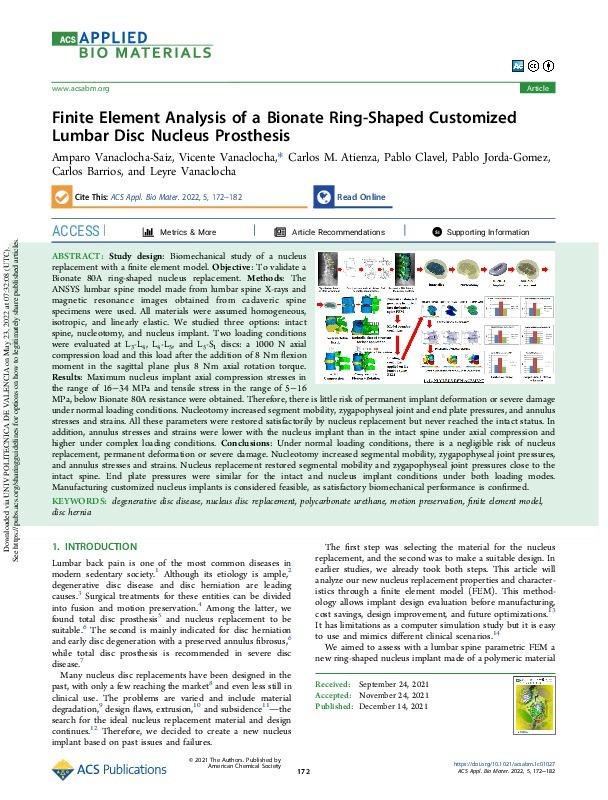JavaScript is disabled for your browser. Some features of this site may not work without it.
Buscar en RiuNet
Listar
Mi cuenta
Estadísticas
Ayuda RiuNet
Admin. UPV
Finite Element Analysis of a Bionate Ring-Shaped Customized Lumbar Disc Nucleus Prosthesis
Mostrar el registro sencillo del ítem
Ficheros en el ítem
| dc.contributor.author | Vanaclocha-Saiz, Amparo
|
es_ES |
| dc.contributor.author | Vanaclocha, Vicente
|
es_ES |
| dc.contributor.author | ATIENZA VICENTE, CARLOS MANUEL
|
es_ES |
| dc.contributor.author | Clavel, Pablo
|
es_ES |
| dc.contributor.author | Jorda-Gomez, Pablo
|
es_ES |
| dc.contributor.author | Barrios, Carlos
|
es_ES |
| dc.contributor.author | Vanaclocha, Leyre
|
es_ES |
| dc.date.accessioned | 2022-05-23T18:03:50Z | |
| dc.date.available | 2022-05-23T18:03:50Z | |
| dc.date.issued | 2022-01-17 | es_ES |
| dc.identifier.uri | http://hdl.handle.net/10251/182800 | |
| dc.description.abstract | [EN] Study design: Biomechanical study of a nucleus replacement with a finite element model. Objective: To validate a Bionate 80A ring-shaped nucleus replacement. Methods: The ANSYS lumbar spine model made from lumbar spine X-rays and magnetic resonance images obtained from cadaveric spine specimens were used. All materials were assumed homogeneous, isotropic, and linearly elastic. We studied three options: intact spine, nucleotomy, and nucleus implant. Two loading conditions were evaluated at L-3-L-4, L-4-L-5, and L-5-S-1 discs: a 1000 N axial compression load and this load after the addition of 8 Nm flexion moment in the sagittal plane plus 8 Nm axial rotation torque. Results: Maximum nucleus implant axial compression stresses in the range of 16-34 MPa and tensile stress in the range of 5-16 MPa, below Bionate 80A resistance were obtained. Therefore, there is little risk of permanent implant deformation or severe damage under normal loading conditions. Nucleotomy increased segment mobility, zygapophyseal joint and end plate pressures, and annulus stresses and strains. All these parameters were restored satisfactorily by nucleus replacement but never reached the intact status. In addition, annulus stresses and strains were lower with the nucleus implant than in the intact spine under axial compression and higher under complex loading conditions. Conclusions: Under normal loading conditions, there is a negligible risk of nucleus replacement, permanent deformation or severe damage. Nucleotomy increased segmental mobility, zygapophyseal joint pressures, and annulus stresses and strains. Nucleus replacement restored segmental mobility and zygapophyseal joint pressures close to the intact spine. End plate pressures were similar for the intact and nucleus implant conditions under both loading modes. Manufacturing customized nucleus implants is considered feasible, as satisfactory biomechanical performance is confirmed. | es_ES |
| dc.description.sponsorship | This project received funding from the European Union's 6th Framework Programme under project number IP 026599-s. | es_ES |
| dc.language | Inglés | es_ES |
| dc.relation.ispartof | ACS Applied Bio Materials | es_ES |
| dc.rights | Reconocimiento (by) | es_ES |
| dc.subject | Degenerative disc disease | es_ES |
| dc.subject | Nucleus disc replacement | es_ES |
| dc.subject | Polycarbonate urethane | es_ES |
| dc.subject | Motion preservation | es_ES |
| dc.subject | Finite element model | es_ES |
| dc.subject | Disc hernia | es_ES |
| dc.subject.classification | INGENIERIA MECANICA | es_ES |
| dc.title | Finite Element Analysis of a Bionate Ring-Shaped Customized Lumbar Disc Nucleus Prosthesis | es_ES |
| dc.type | Artículo | es_ES |
| dc.identifier.doi | 10.1021/acsabm.1c01027 | es_ES |
| dc.relation.projectID | info:eu-repo/grantAgreement/EC//026599-s/ | es_ES |
| dc.rights.accessRights | Abierto | es_ES |
| dc.contributor.affiliation | Universitat Politècnica de València. Departamento de Ingeniería Mecánica y de Materiales - Departament d'Enginyeria Mecànica i de Materials | es_ES |
| dc.description.bibliographicCitation | Vanaclocha-Saiz, A.; Vanaclocha, V.; Atienza Vicente, CM.; Clavel, P.; Jorda-Gomez, P.; Barrios, C.; Vanaclocha, L. (2022). Finite Element Analysis of a Bionate Ring-Shaped Customized Lumbar Disc Nucleus Prosthesis. ACS Applied Bio Materials. 5(1):172-182. https://doi.org/10.1021/acsabm.1c01027 | es_ES |
| dc.description.accrualMethod | S | es_ES |
| dc.relation.publisherversion | https://doi.org/10.1021/acsabm.1c01027 | es_ES |
| dc.description.upvformatpinicio | 172 | es_ES |
| dc.description.upvformatpfin | 182 | es_ES |
| dc.type.version | info:eu-repo/semantics/publishedVersion | es_ES |
| dc.description.volume | 5 | es_ES |
| dc.description.issue | 1 | es_ES |
| dc.identifier.eissn | 2576-6422 | es_ES |
| dc.identifier.pmid | 35014829 | es_ES |
| dc.identifier.pmcid | PMC8767544 | es_ES |
| dc.relation.pasarela | S\460519 | es_ES |
| dc.contributor.funder | European Commission | es_ES |








